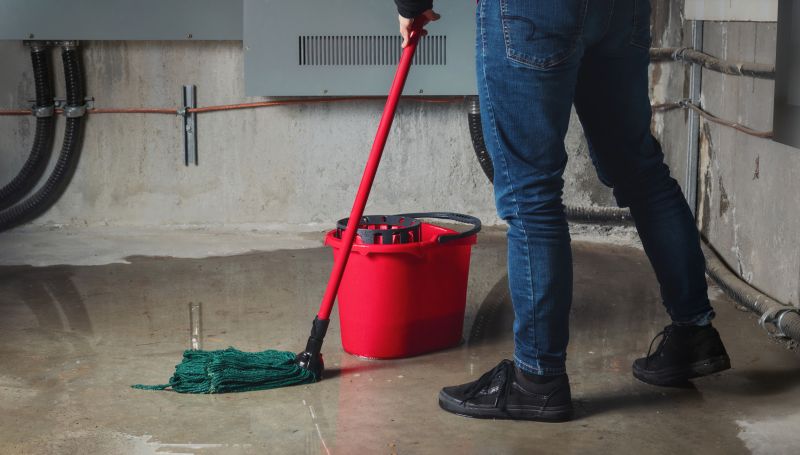Top Products For Flooded Basement Cleanup You Need to Know
Discover essential tools and equipment that make flood cleanup faster, safer, and more effective for any basement emergency.
 Flooded basements can pose significant challenges, requiring effective cleanup solutions to prevent property damage and mold growth. When dealing with water intrusion, selecting the right products is essential to efficiently remove standing water, dry out affected areas, and restore safety. From powerful water extraction tools to durable drying equipment, a variety of products are designed to address different levels of flooding severity and specific needs. Proper use of these tools can help mitigate long-term structural issues and promote a healthier living environment.
Flooded basements can pose significant challenges, requiring effective cleanup solutions to prevent property damage and mold growth. When dealing with water intrusion, selecting the right products is essential to efficiently remove standing water, dry out affected areas, and restore safety. From powerful water extraction tools to durable drying equipment, a variety of products are designed to address different levels of flooding severity and specific needs. Proper use of these tools can help mitigate long-term structural issues and promote a healthier living environment.
Top Overall Option
Heavy-Duty Water Pump
A reliable heavy-duty water pump serves as the cornerstone of flood cleanup efforts, capable of swiftly removing large volumes of water from basements. Its robust construction and high flow rate make it suitable for various flooding scenarios, from minor leaks to significant inundations. When paired with appropriate hoses and filters, this type of pump can efficiently drain water, helping to prevent further damage and facilitate drying. Its portability and ease of use make it a versatile choice for both homeowners and professionals seeking a dependable solution for flood emergencies.
Types of Products For Flooded Basement Cleanups
Submersible Water Pumps
Designed to operate submerged in water, these pumps are effective for removing standing water from basements and crawl spaces.
Centrifugal Water Pumps
Ideal for high-volume water removal, these pumps offer powerful flow rates suitable for large-scale flooding.
Wet/Dry Vacuums
Versatile for picking up residual water and debris, these vacuums are essential for initial cleanup and detailed drying.
Industrial Air Movers
These devices accelerate air circulation to facilitate faster drying of walls, floors, and other surfaces.
Commercial Dehumidifiers
Designed to extract moisture from the air, dehumidifiers help reduce humidity levels after flooding.
Moisture Meters
Tools for detecting hidden moisture in walls and floors, ensuring comprehensive drying.
Water Detection Sensors
Automatic sensors that alert you to ongoing leaks or hidden water pockets.
Squeegees
Manual tools for pushing water out of small areas or along floors during cleanup.
Flood Barriers
Temporary barriers to prevent further water intrusion during cleanup efforts.
Waterproof Tarps
Cover exposed areas to prevent additional water entry and protect belongings.
Air Scrubbers
Devices that filter airborne contaminants, helping to improve indoor air quality after flooding.
Portable Generators
Provide reliable power to operate electrical equipment during flood cleanup, especially in power outages.
Waterproof Storage Bins
Secure storage options for belongings and tools during flood events.
Sanitizing Sprays
Disinfectant solutions for cleaning and sanitizing flood-affected areas to prevent mold and bacteria growth.
Popular Choices
Widely used for its capacity to handle significant water removal tasks efficiently.
Commonly chosen for their ability to speed up drying times in large spaces.
Popular for reducing moisture levels after initial water removal efforts.
A versatile tool frequently selected for detailed cleanup and residual water extraction.
Helpful for pinpointing hidden moisture pockets, making it a common choice among cleanup professionals.
Valued for early leak detection and ongoing water monitoring during recovery.
Often used to prevent additional flooding during cleanup operations.
Frequently employed to shield unaffected areas from water ingress.
Popular for improving indoor air quality during and after flood cleanup.
A common choice for ensuring continuous power supply in flood-affected areas.
Used regularly for disinfecting surfaces after water removal to prevent mold growth.
Understanding the range of available products can empower homeowners and professionals alike to make informed decisions. Portable water pumps and wet/dry vacuums are common initial responders, capable of quickly removing large volumes of water. Follow-up drying often involves industrial air movers and dehumidifiers, which work together to accelerate evaporation and moisture removal from walls, floors, and other surfaces. Additionally, moisture meters and water detection sensors can assist in identifying hidden water pockets, ensuring thorough cleanup.
Safety considerations are paramount during flood cleanup. Using protective gear such as waterproof gloves, masks, and boots helps prevent exposure to contaminated water and mold spores. Proper electrical safety protocols must be followed when operating electrical-powered equipment in wet conditions. Regular maintenance and inspection of equipment ensure optimal performance and longevity. Investing in high-quality, versatile tools can make flood cleanup more manageable, reducing the risk of mold development and structural deterioration over time.
Key Buying Considerations
- Water removal capacity and flow rate of pumps or vacuums to match the severity of flooding.
- Portability and ease of transportation, especially for larger equipment.
- Durability and build quality to withstand frequent or heavy-duty use.
- Compatibility of hoses, fittings, and accessories for seamless operation.
- Electrical safety features, including ground fault protection and waterproof controls.
- Noise levels, particularly for equipment used in occupied or sensitive environments.
- Ease of operation and maintenance requirements for long-term reliability.
- Power source options, such as electric or gasoline-powered units, based on site conditions.
- Additional features like automatic shutoff, adjustable settings, or built-in filters.
- Size and storage considerations for equipment storage and transport.
- Availability of replacement parts and customer support services.
- Cost and budget considerations balanced with equipment capability.
- Suitability for both residential and commercial flood cleanup scenarios.
- Compatibility with existing tools and safety gear.
- Environmental considerations, such as emissions and waste disposal, if relevant.
